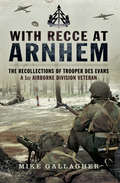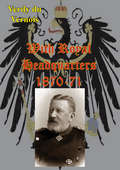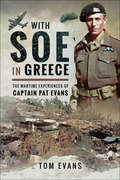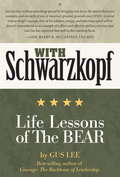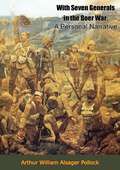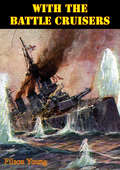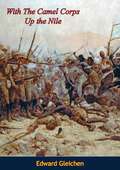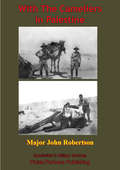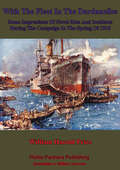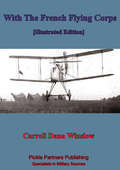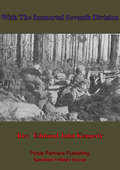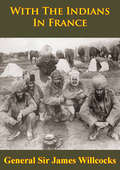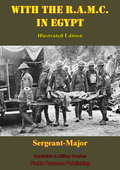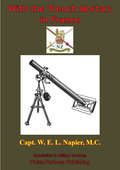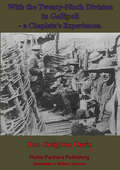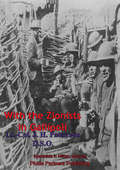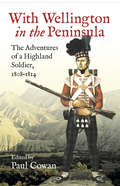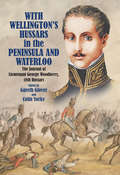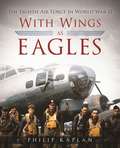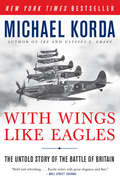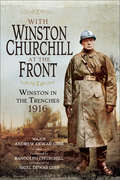- Table View
- List View
With Recce at Arnhem: The Recollections of Trooper Des Evans, a 1st Airborne Division Veteran
by Mike GallagherDetermined to 'do his bit' Des Evans absconded from a reserved occupation and joined the newly formed Reconnaissance Corps. He saw action in North Africa and Italy before being evacuated back to England with pneumonia in early 1944. Fully recovered he volunteered as a wireless operator with 1st Airborne Reconnaissance Squadron and after parachute training joined C Troop before the ill-fated but glorious attempt to seize the Rhine Bridge at Arnhem.Des vividly describes the intense action that followed the drop. Ambushed twice and badly wounded he was made a POW and eventually succeeded in escaping.Fresh first-hand accounts of the bitter fighting at Arnhem are rare indeed and this one is brutally honest, at times shockingly so. Des Evans was born in Liverpool in 1923. Despite being in a Reserve Occupation he finally succeeded in joining the Army. This book covers his wartime service in North Africa, Italy and at Arnhem. Post war he served in Italy, Palestine, Germany and the Suez Canal Zone. Cuckolded by his first wife he was convicted of the manslaughter of her lover. On release from prison he met Betty and they enjoyed nearly 40 years together until dementia necessitated residential care. Betty died in March 2010 and Des followed her three months later.
With Rommel in the Desert: Tripoli to El Alamein (Images of War)
by David Mitchelhill-GreenThis WWII pictorial history illustrates Nazi Germany&’s North African campaign, showing life under Rommel through vivid wartime photographs. Prior to the outbreak of World War II, the German Army had focused exclusively on preparations needed to wage war in continental Europe. The threat of an Italian collapse in North Africa in early 1941, however, prompted Hitler to aid his ally by sending an armored blocking force to Libya. Not content to merely thwart the British from capturing Tripoli, Lieutenant-General Erwin Rommel harried his inexperienced expeditionary force eastward towards the Nile Delta.With Rommel in the Desert presents a pictorial narrative of the unfolding conflict from the arrival of the Deutsches Afrikakorps until Rommel's departure from the battlefield in March 1943. These rare wartime photographs show daily life in the desert war, with its shifting fortunes and unique challenges. Primarily viewed from the perspective of ordinary combatants, this is their personal record of serving with Rommel in the desert.
With Royal Headquarters 1870-71 [Illustrated Edition]
by General Julius Adrian Friedrich Wilhelm von Verdy du VernoisIncludes the Franco-Prussian Map Pack with over 35 maps, plans and diagrams of the engagements of the warJulius von Verdy du Vernois was a noted Prussian General and strategist, he served with great distinction in the Austro-Prussian war of 1866 and participated in the climactic battle of Königgratz. He was appointed to the General Staff in 1867 as head of the intelligence section becoming a close assistant and confidant of the great Graf von Moltke. His chief fame rests on his service with the German Royal headquarters as one of high-ranking "demi-gods" of the General staff who enabled von Moltke to keep control of the massive German army as they destroyed the French armies so rapidly and successfully."THESE "Personal Recollections of the War of 1870-71," now first issued in book form, have already been partially published in articles which appeared in the "Deutsche Rundschau" in 1874 and 1895. Going again through my letters and the notes in my diary of that period, I have here and there added additional matter."But still they are nowise intended to form an exhaustive description of the war, or even a complete record of personal experiences. Their publication is due to the renewed interest in those great events which the twenty-five years' jubilee has awakened, and their object is a limited one, viz. to give an insight into the daily life of the Royal Headquarters Staff during those times. The opinions held and mental impressions formed at particular moments with regard to the great events of the war are recorded for the most part in the form in which they were noted down at the time, without regard to whether, in the light of better information, they subsequently proved correct or wide of the mark. For thus only can the "Recollections" give a faithful picture of the views obtaining at particular junctures."- von Verdy
With SOE in Greece: The Wartime Experiences of Captain Pat Evans
by Tom EvansPat Evans parachuted into German-occupied Northern Greece in September 1943. His mission as a SOE operative was to support the Greek resistance movement, carry out sabotage and commando operations and gather military intelligence.By this time Greece was not only a country ravaged by a brutal occupation but being torn apart by fending political factions on the edge of civil war. Evans had to walk a tight-rope between the Germans, the Communist directed ELAS, Macedonia irredentists and his own SOE masters in Cairo and Allied High Command.After the Nazis withdrew in late 1944, he was sent to Northern Greece to try and restore some form of normality amid the chaos of civil war. His success can be measured by the warmth in which the locals still remember him, over 70 years on.This book draws on a wide range of sources, including SOE and War Cabinet papers but it is Pat Evans unpublished letters and reports that give the reader an insight into the challenge that he faced, both operationally and politically.The result is a thrilling and informative book.
With Schwarzkopf
by Gus LeeWith Schwarzkopf is Gus Lee's remembrance of his mentor and friend H. Norman Schwarzkopf, and his firsthand account of how Schwarzkopf shaped his life. In 1966, Lee, a junior-year cadet at West Point, was bright, athletic, and popular. He was also on the verge of getting kicked out. Nearing the bottom of his class due to his penchant for playing poker and reading recreationally instead of studying engineering, he was assigned a new professor: then-Major Norman Schwarzkopf. Schwarzkopf's deeply principled nature and fierce personality took hold of the wayward cadet, and the two began meeting regularly and discussing what it meant to be a scholar, a soldier, and a man. Lee's vibrant, witty narrative brings his more than forty-year relationship with Schwarzkopf to life. Readers get an inside look at West Point culture; they see Schwarzkopf's bristling anger with his rebellious pupil as well as his tenacity, intellect, and moments of surprising emotional warmth; and they watch as Lee starts to absorb his teachings. As he left West Point and took on more professional and personal roles, Lee approached every crisis or difficult decision by channeling his mentor. Over the years, Schwarzkopf's instilled values, wise counsel, and warm conversations shaped Lee and brought the two together in an unlikely friendship. In With Schwarzkopf, Lee passes along the lessons he learned so future generations can hear Schwarzkopf's important teachings.
With Seven Generals in the Boer War: A Personal Narrative
by Arthur William Alsager PollockWith Seven Generals in the Boer War: A Personal Narrative by Arthur William Alsager Pollock is an engaging firsthand account of the Second Boer War (1899–1902), offering readers a unique perspective from someone who experienced the conflict up close. As a military observer accompanying multiple British generals, Pollock provides not only a detailed chronicle of key campaigns but also personal insights into the personalities, strategies, and challenges that shaped the course of the war.Pollock’s narrative captures the complexity of Britain’s struggle against the Boer forces in South Africa, describing the harsh landscapes, grueling battles, and shifting tactics employed by both sides. He served under seven prominent generals—including Lord Roberts and Lord Kitchener—and his observations illuminate the different leadership styles, strategies, and operational decisions that defined the conflict. From sieges and skirmishes to the difficulties of maintaining morale and logistics, Pollock’s detailed writing paints a vivid picture of the day-to-day realities of war.What makes this book particularly compelling is Pollock’s personal reflections on the human side of the conflict, offering stories of camaraderie, hardship, and perseverance among soldiers. His narrative also touches on the political complexities surrounding the war and the impact of military campaigns on both British troops and the Boer population.With Seven Generals in the Boer War is not only a war memoir but also an insightful commentary on leadership, strategy, and the nature of colonial warfare. Pollock’s balanced perspective and engaging prose make this an essential read for those interested in military history, the Boer War, or firsthand accounts of 19th-century conflict. Through his narrative, Pollock offers readers a rare glimpse into a pivotal war that shaped the political and cultural landscape of South Africa and the British Empire.
With The Battle Cruisers [Illustrated Edition]
by Filson YoungContains 54 illustrations and 3 maps.By the time that Filson Young found himself aboard Admiral Sir David Beatty's flagship in the North Sea just before the First World War he had a varied career as a novelist, journalist and war correspondent. He had been a special reporter during the Boer War and also written about naval subjects such as the voyages of Christopher Columbus and the Titanic. In this novel, also known as "With Beatty in the North Sea" chronicles his time as a Royal Naval Reserve Lieutenant with the Grand Fleet in 1915-1916, and he provides a gripping eye-witness account of the Battle of Dogger Bank. He left the Navy in 1916 before the battle of Jutland. He recorded his experiences a few years later of his life at sea in the Grand Fleet in this book which captures but the action of the battle and the personalities of the crews he served with.
With The Camel Corps Up the Nile
by Edward GleichenA fine account by one of its officers of the role of the Camel Corps in the abortive attempt to save Gen. Gordon and Khartoum in 1885. Despite the grim context the book manages to be witty on the subject of camels.An intriguing account of the part played by the Camel Corps in the 1885 expedition mounted—too late, in the author’s opinion—by the Gladstone Government in the forlorn hope of saving Khartoum from the forces of the Mahdi, and rescuing General Gordon. Gleichen was an aristocratic officer of the Grenadier Guards seconded—to his great joy—to the Camel Corps from garrison duty in Dublin. His book is a record of battles fought and won, of dangers run and difficulties overcome—and of ultimate frustration when the ‘worst possible news’ arrives of Gordon’s death. En route the reader learns a great deal about the behaviour and management of camels. With four appendices on the Camel Corp’s composition and losses, and illustrated with the author’s own talented and witty drawings and a map.-Print ed.
With The Cameliers In Palestine
by Major James Robertson"Major Robertson is doing a great service to his old comrades in publishing this History of the New Zealand Companies of the Camel Corps. In New Zealand as in Australia, it is only natural that more interest has been shown in the Western theatre of the Great War than in the Eastern theatres as the great bulk of their soldiers served in the former. The Palestine campaign is consequently little known in these countries. Nevertheless, that campaign has been more used as a "text book" for the examination of officers in the British Army than any other phase of the Great War. In fact it bids fair to take the place of Stonewall Jackson's campaign in the Shenandoah Valley which had been used for this purpose for several generations before the Great War. In spite of the fact that no American troops fought in Palestine, Lord Allenby's campaign is better known in the United States Army, particularly in the cavalry, than it is in Australia and New Zealand whose troops played such an important part in it."Owing to its extreme mobility and suitability for desert warfare, The Imperial Camel Corps Brigade had many and varied roles to fill, all of which were filled with credit to the brigade and its gallant leader. The map of Egypt and the Sinai Peninsula is better known to its members than to any other troops. In Palestine where there is little desert, the particular value of their camels largely disappeared, but the brigade held its own with the cavalry in the fighting round Beersheba, the pursuit up the Philistine Plain, and the raid on Amman. After their transformation to cavalry, as the 14th and 15th Australian Light Horse Regiments and the 2nd New Zealand Machine Gun Squadron, the Australian and New Zealand "Cameliers" well upheld their traditions in the Battle of Megiddo and the advance on, and capture of, Damascus."-Introduction
With The Fleet In The Dardanelles, Some Impressions Of Naval Men And Incidents During The Campaign In The Spring Of 1915
by William Harold. D. Price Sir Everard Fraser K. C. M. G.As warfare ground to a halt in the static, bloody trenches of the Western Front in 1914, the Allied command sought to lever Germany's Turkish allies out of the war. Although the British had but a small standing peacetime army, she possessed the largest fleet in the world, and planned to use the awesome power of her huge naval guns to blast a passage through the Turkish defences of the strait. Constantinople would thereby be threatened and Turkey forced to sue for peace. The plan was bold, ambitious and doomed to fail.As the confident fleet steamed up through the Mediterranean, Padre Price kept a diary of his experiences and anecdotes of the Jolly Tars. However, his notes are filled with danger and bloodshed as the fleet encounter the brave and stubborn shore batteries, taking its baptism of fire. Though gallant and bloodied by the shells of the enemy, the fleet could not force the passage - a fateful failure that would lead to the landings at Gallipoli and further allied failures. Author -- Price, William Harold. D. 1917Preface -- Sir Everard Fraser K.C.M.G. (1859-1922)Text taken, whole and complete, from the edition published in London, A. Melrose, ltd. 1915Original Page Count - xvi and 124 pages.Illustrations -- 6 Illustrations.
With The French Flying Corps [Illustrated Edition]
by Carroll Dana Winslow"Petite bleu to pilote-a young American's flight into warThe author of this book, Dana Winslow, was a young American in Paris as France recruited men to fight the invading German forces of the Kaiser at the outbreak of the First World War. Feeling strongly for the plight and cause of the French, he immediately went to Les Invalides and there enlisted in the French Flying Corps as a trainee pilot. This vital first hand account is an essential source work of the period which reveals the training of the earliest French military aviators of the great conflict on the Western Front and it follows Winslow on his 'rite of passage' from inexperienced civilian, to lowly and little regarded aeronautical student (petit bleu) through his first perilous days in the combat zone to his time as an experienced and much prized pilote in the hostile skies over the trenches of the front lines. As may be expected, Winslow takes us to his war of dogfights, mid-air collisions, artillery spotting and reconnaissance in vivid-if humbly recounted-detail. Winslow's book is especially valuable as an insight into the variety of aircraft employed by the French during his time with them and he provides useful details as to their construction, abilities, applications and flying characteristics such-as those of the peculiar 'cut down' Bleriot that was 'the Penguin.' He also gives an interesting view of the business of military flying in wartime, which he distinguishes as entirely separate from piloting, as he describes it, as a mere 'conductor.' Accounts of battling in the air during the Great War are not common, so this volume is, of course, a welcome addition to their limited number and will be of interest to everyone interested in the subject."--Leonaur Print Version.Author -- Winslow, Carroll Dana.Text taken, whole and complete, from the edition published in New York, C. Scribner's sons, 1917.Original Page Count - xi and 226 pagesIllustration -- 15 illustrations.
With The Immortal Seventh Division
by Right Reverend the Lord Bishop of Winchester Rev Edmund John KennedyEven among the highly-trained and professional soldiers of the B.E.F in 1914 the men of the Seventh division stood apart for their bearing and training, for the contained no reservists; all were full-time soldiers. Accompanying these uncompromising men, was Reverend Kennedy, assigned to the 20th Brigade, which was to see much action during the opening months of the First World War.The Padré and his beloved soldiers trekked into Belgium to take part in the First Battle of Ypres, to find the local inhabitants welcoming but the atmosphere filled with apprehension. As the Seventh finally clashed with the invading Germans the author found his role turned from an observer to participant in offering comfort and even absolution to the wounded and dying. A man of committed faith he continued to minster to his men as they fought in the desperate action around Ypres.After a year with the troops the Reverend returned to England and composed his memoirs of the period but did not survive long enough to see their publication.Author -- Rev. Edmund John Kennedy d. 1915.Preface -- Right Reverend the Lord Bishop of Winchester.Text taken, whole and complete, from the edition published in London, Hodder and Stoughton, 1916.Original Page Count - x and 193 pages
With The Indians In France
by General Sir James Willcocks GCB GCMG KCSI DSOThe memoirs of Sir James Willcocks stand apart from other diaries and recountings of senior British Officers on the Western Front during the First World War; although a British Gentleman, his heart had long been taken by charms of India. Willcocks was a long serving officer in the Indian Army and led his men all the way from Nepal, Scinde, the Punjab and Bengal to the mud and blood of the trenches in Northern France and Belgium.The fighting prowess and sacrifice of these brave Indian soldiers has often been forgotten tale, but their commanding General tells of their efforts and victories with justified pride throughout his work which covers the early months of the war until his resignation in late 1915. The Indian Corps was heavily engaged throughout at la Bassée, Messines, Armentières, Neuve Chapelle, Aubers Ridge and Festubert and finally at the brutal blood-letting during the battle of Loos.
With The R.A.M.C. In Egypt [Illustrated Edition]
by Sergt. MajorA veteran Non-Commissioned Officer tells of his experiences among the shells, wounded and diseases of the Egyptian Campaign of World War One. Includes 32 illustrations."THIS account of the work of the Royal Army Medical Corps in Egypt from the earliest days of the British Occupation in 1883 to the close of the Sinai Desert Campaign at the beginning of 1917, is in no way official, nor must it be regarded as in any sense officially inspired...It is due to the reader, however, to say at once that, though the book must be taken solely as the independent work of one man possessing no official status whatever, it has been produced under privilege, without which, indeed, it could never have been written. For the facts as to the doings of the R.A.M.C. on the battlefield, and in respect of the Corps' many activities in other branches of medical war service, the writer has been able to draw largely on his own experience, it having been his lot to serve as a member of the Royal Army Medical Corps both with the Dardanelles Army and with the Egyptian Expeditionary Force...Very few names are here set down, albeit many fine achievements and instances of singular devotion to duty have been necessarily recorded. Seeing that it was practically impossible to mention by name all in the Service who had won, or deserved to win, distinction, it was thought better to leave names alone altogether, and to let the great sum of heroism, enterprise, exertion, merge itself into the common honour of the Corps."
With The Trench Mortars In France [Illustrated Edition]
by Captain William Esmonde Lennox NapierIllustrated with a portrait of the author and multiple illustrations of the mortar weapons"The following account of the work of the Light Trench Mortars in France is given in order that the usefulness in the Great War of this wonderful invention of Stokes may be more widely known in New Zealand than at present is the case. The information given in the following pages is all of more or less value because it has been gained from personal experience in the field in France and with the help of official war diaries of different batteries engaged both in trench warfare and in attack, and these batteries are considered to have taken part in more offensive actions than any other batteries in the whole British Army, commencing from Armentières in February, 1916, right up to the end of the War.Very little has been said in any other book written during or since the War, not even in the History of the N.Z.E.F., nor in the history of any of its regiments, of the Trench Mortars or their work, and, therefore, without making this little brochure an effort for people to read by supplying a lot of technical detail, I think it preferable to narrate in simple language some of the principal achievements of the New Zealand Expeditionary Force with this wonderful invention of Sir Wilfred Stokes, after its introduction to the Army."--Introduction
With The Twenty-Ninth Division In Gallipoli, A Chaplain's Experiences. [Illustrated Edition]
by Rev Creighton Oswin"The padre of the 86th Brigade, 29th Division, gives an account of his experiences at Gallipoli where he landed on 25th April 1915 to his evacuation on medical grounds on 12th August....it covers the period 27th January 1915, when he reported to the HQ of the newly formed 29th Division in Leamington, to 12th August 1915 when he arrived in Alexandria having been evacuated sick (diphtheria) from the Peninsula. The 86th Brigade was a Fusilier Brigade with 2nd Royal Fusiliers, 1st Lancashire Fusiliers, 1st Royal Munster Fusiliers and 1st Royal Dublin Fusiliers, and it was the first to land on 25th April 1915. It was with the first two mentioned that Creighton had most contact and they feature prominently in this account. The other two battalions, being recruited mainly from the south of Ireland, were predominantly RC.Creighton had come straight from civvy street and took a little while to find his feet among regular troops....This account is based on his diary and he took pains to write only what he got firsthand and from personal observation and he has tried to be as accurate as possible.The interesting photos were borrowed from the CO of 2nd RF and his narrative does give a feel for the conditions and fighting on the Peninsula. At one stage he gives vent to his feelings after a fruitless attack by a brigade of the newly arrived 52nd (Lowland) Division which cost over fifty percent casualties: "These things seem to happen every battle. The amount of unnecessary lives simply thrown away is appalling."...The book closes with a chapter by the BM, Major H.M. Farmar, on the landing of the 86th Brigade and the subsequent operations till 3rd May."N&M print versionAuthor -- Rev. Creighton Oswin, 1883-1918Text taken, whole and complete, from the edition published in London, Longmans, Green and co., 1916.Original Page Count - xiv and 191 pages.Illustrations -- 26 maps and Illustrations.
With The Zionists In Gallipoli
by Lt.-Col J. H. Patterson"Rare account by the C.O. of the Judeans - a unit of Jewish Zionists within the British army who helped drive the Ottoman Turks out of Palestine in 1917-18.This is an extraordinary account of one of the most unusual units ever to have fought in the ranks of the British army. 'The Judeans' were a battalion of Jewish soldiers raised during the Great War specifically to serve in Palestine, which, then as now, was a politically and racially sensitive area. Set against the background of the 1917 Balfour Declaration, which pledged British support for establishing a homeland for the Jewish people in Palestine, this is the account of the Judeans by its outspoken (non-Jewish) Commanding Officer, Col. J. H. Patterson, who is palpably proud of having led the Judeans, which he rightly describes as a 'unique unit' whose formation was 'unprecedented in our annals'...Patterson's account of the victorious 1918 campaign that swept the Turks out of what is now Israel, Palestine and Jordan, is shot through both with his pride in his men, when he goes as far as claiming that the campaign 'was actually pivoted on the sons of Israel who were once again fighting the enemy, not far from the spot where their forefathers had crossed the Jordan under Joshua'. Patterson is also - unusually, given the high degree of anti-Semitism then prevalent in Britain's officer class - highly critical of his fellow officers for discriminating against the Judeans, and other Jewish settlers in Palestine. This book is a rare insight into a remarkable episode in Anglo-Jewish history, and should interest anyone wishing to know more of the background to current conflicts in the Middle East. It is illustrated with 22 photographs of officers of the Judeans and Palestinian scenes, including Biblical sites."-N&M Print ed.
With Their Backs To The World: Portraits from Serbia - from the bestselling author of the Bookseller of Kabul
by Asne SeierstadFrom the bestselling author of THE BOOKSELLER OF KABUL comes a remarkable exploration of the lives of ordinary Serbs under the regime of Slobodan Milosevic-during the dramatic events leading up to his fall, and finally in the troubled years that have followed. Asne Seierstad traveled extensively through Serbia between 1999 and 2004, following the lives of people from across the political spectrum. Her moving and perceptive account follows nationalists, Titoists, Yugonostalgics, rock stars, fugitives and poets. Seierstad brings her acclaimed attention to detail to bear on the lives of those whom she encounters in With Their Backs to the World, as she creates a kaleidoscopic portrait of a nation made up of so many different-and often conflicting-hopes, dreams, and points of view.
With Their Backs To The World: Portraits from Serbia - from the bestselling author of the Bookseller of Kabul
by x Asne SeierstadFrom the bestselling author of THE BOOKSELLER OF KABUL comes a remarkable exploration of the lives of ordinary Serbs under the regime of Slobodan Milosevic-during the dramatic events leading up to his fall, and finally in the troubled years that have followed. Asne Seierstad traveled extensively through Serbia between 1999 and 2004, following the lives of people from across the political spectrum. Her moving and perceptive account follows nationalists, Titoists, Yugonostalgics, rock stars, fugitives and poets. Seierstad brings her acclaimed attention to detail to bear on the lives of those whom she encounters in With Their Backs to the World, as she creates a kaleidoscopic portrait of a nation made up of so many different-and often conflicting-hopes, dreams, and points of view.
With Wellington in the Peninsula: The Adventures of a Highland Soldier, 1808–1814
by Paul CowanFew men from the 71st Highland Light Infantry who sailed from Cork with Wellington to Portugal in 1808 returned to the Irish port six years later. The author of Vicissitudes in the Life of a Scottish Soldier was one of the survivors and claims only four other men from his company came through the entire six years with him. As one of Wellington's elite Light Infantry units the 71st were in the fore of the fighting in some of the hardest fought battles of the Peninsular War. The book was controversial on its release in 1827 for its unvarnished and unsentimental account of the grim war against the French in Spain, the Netherlands, Portugal and France itself. A cynic with a highly developed sense of humour, the author was not afraid to criticise his superiors, be they thieving sergeants or officers who were far from gentlemen. Editor Paul Cowan draws on little known diaries and other accounts written by the author's contemporaries to corroborate and expand on this frank but all too long neglected first-hand picture of the war in the Peninsula as it was really fought.
With Wellington's Hussars in the Peninsula and Waterloo: The Journal of Lieutenant George Woodberry, 18th Hussars
by Gareth GloverGeorge Woodberry was commissioned into the 18th Light Dragoons (Hussars) as a cornet on 16 Jan 1812, and joined Wellingtons army as a lieutenant, seeing action in the key battles of 1813 and 14 Moralles, Vittoria, Nivelle, Nive, Orthes, Croix dOrade and the final battle of the war at Toulouse. He was wounded at Mendionde in a clash with French cavalry as Wellington advanced into France. He also served in the 1815 campaign, being at Waterloo and the march to Paris.What is most remarkable is that Woodberry found time to record events at length in his journal almost every single day. This enables the reader to trace accurately the movements of the 18th Hussars and Wellingtons army in general with precision. It also provides an insight into life on campaign in Spain, France and Belgium with the British Army of the early nineteenth centuryHis lively, detailed and entertaining account of his time in Wellingtons army is matched by the unusual story of the history of his journal. It was published once before, in 1898, but in French by a Paris-based publisher. The original journal, in two leather-bound volumes, has since been lost, but the French edition has now been translated back into English by renowned Napoleonic historian Gareth Glover and is published in the UK for the first time.
With Wings As Eagles: The Eighth Air Force in World War II
by Philip KaplanBeginning in 1942, the Eighth Air Force began a precision bombing raid offensive deep into Nazi Germany, embarking from bases in rural England. Nearly 350,000 Americans were transplanted to English soil, joining their British colleagues for this joint Allied offensive. For many it was a period of great risk, and arguably the greatest adventure of their lives.With Wings As Eagles celebrates the heroics of these pilots and their missions. A lavishly illustrated, full-color, hardcover original, the narrative is the result of the author’s exclusive interviews with many of the pilots and crew, as well as research from contemporary diaries, journals, and scrapbooks. Readers relive the nostalgia and vivid reminiscences - of days of seemingly endless boredom and fatigue, the loneliness of soaring in an aluminum cocoon four miles over an intended target, and a surprising account of parachuting onto German soil and being captured by women and children.With Wings As Eagles relives the drama and history of an heroic era.
With Wings Like Eagles
by Michael KordaIn the summer of 1940, fewer than three thousand young fighter pilots of the Royal Air Force stood between Hitler and the victory that seemed almost within his grasp.In this superb history of three epic months that saved the world, Michael Korda brilliantly re-creates the intensity of combat in "the long, delirious, burning blue" of the sky above southern England--while tracing, perhaps for the first time, the entire complex web of political, diplomatic, scientific, industrial, and human decisions during the 1930s that inexorably led to the world's first, greatest, and most decisive air battle. With Wings Like Eagles brings to vivid life the extraordinary men and women on both sides of the conflict--from Winston Churchill, Neville Chamberlain, and Reichsmarschall Hermann Göring to the ground crews, the German pilots, the American volunteers, and the courageous airmen and airwomen of the RAF.
With Wings Like Eagles: A History of the Battle of Britain
by Michael KordaIn the summer of 1940, fewer than three thousand young fighter pilots of the Royal Air Force stood between Hitler and the victory that seemed almost within his grasp. In this superb history of three epic months that saved the world, Michael Korda brilliantly re-creates the intensity of combat in "the long, delirious, burning blue" of the sky above southern England--while tracing, perhaps for the first time, the entire complex web of political, diplomatic, scientific, industrial, and human decisions during the 1930s that inexorably led to the world's first, greatest, and most decisive air battle. With Wings Like Eagles brings to vivid life the extraordinary men and women on both sides of the conflict--from Winston Churchill, Neville Chamberlain, and Reichsmarschall Hermann GÖring to the ground crews, the German pilots, the American volunteers, and the courageous airmen and airwomen of the RAF.
With Winston Churchill at the Front: Winston on the Western Front, 1916
by Andrew Dewar GibbFollowing his resignation from the Government after the disastrous Gallipoli campaign, Winston Churchills political career stalled. Never one to give in, Churchill was determined to continue fighting the enemy.He was already a Major in the Territorial Reserve and he was offered promotion to Lieutenant Colonel and with it command of a battalion on the Western Front. On 5 January 1916, Churchill took up his new post with the 6th (Service) Battalion, Royal Scots Fusiliers. The battalions adjutant was Captain Alexander Dewar Gibb who formed a close relationship with Churchill that lasted far beyond their few weeks together in the war.Dewar Gibb subsequently wrote an account of his and Churchills time together in the trenches. Packed with amusing anecdotes and fascinating detail, Gibbs story shows an entirely different side to Churchills character from the forceful public figure normally presented to the world. Churchill proved to be a caring and compassionate commander and utterly fearless. Despised on his arrival, by the time he departed he was adored by his men.Supplemented with many of Churchills letters, the observations of other officers and additional narrative this is the most unusual and absorbing account of this part of Churchill's life that has ever been told.
